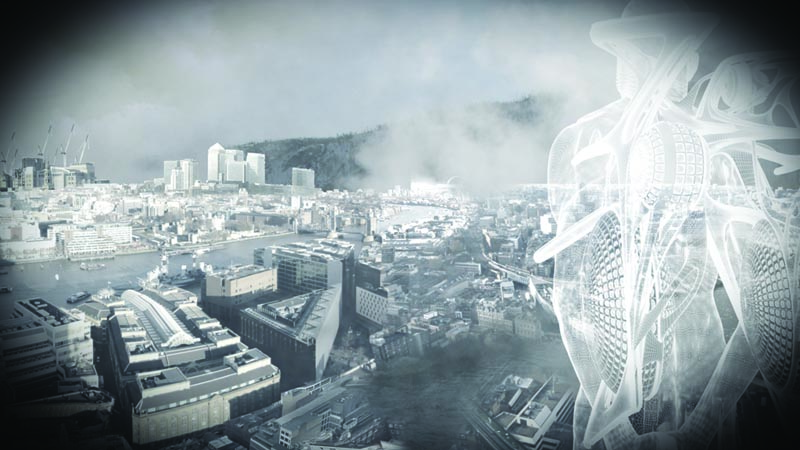Reality Bytes
Where is the rain in the forest? The falling leaves have turned into the data of the skin, how come? Today’s nature is a Kunstlandschaft which acts as sense-able landscape extending our bodily perception; the so beloved morning dew became digital.
Cityscapes in contemporary architecture are designed by pushing the boundaries of the profession and by incorporating data which oscillate between human and machine. Conceiving of the city as digital landscape and smart entity makes the cityscape a vehicle towards continuous improvement of quality of life and competitiveness amidst constantly changing circumstances. Using the new possibilities of data gathering, exchange and analysis, a cityscape is a digital landscape that enables all of its components (i.e. inhabitants and digital applications likewise) to react to, adapt to and take part in the changing conditions of its intrinsic systems. In a digital cityscape, decisions are informed by multiplicity and are participatory. Citizens, infrastructure, services, and the natural environment become communicative, while self-regulating the urban metabolism.
The underlying blueprint of a cityscape resembles the organisation and function of the human brain. This fact leads to immersive conditions and an increased complexity that redefine presets, processes and aims of contemporary architectural design – thus we face a paradigm shift.
The Technobody is a spatial interface between being and nature, a conglomerate continuously negotiating between ephemeral big data and our built “Kunstlandschaft”.Today’s cityscapes blur the boundaries between what was once termed natural and digital. Cities have become sense-able and animatronic landscapes extending our bodily perception and becoming part of it.
Cityscapes resemble an epiphenomenon, meaning anyone’s thought, consciousness, and cognition completely depend on the cityscapes’ material reality – consisting of an intrinsic relationship of data, digital and material processes and entities, and thus breaking with the notion of the mind-body split. Observations derived from cybernetics emphasise this notion[1]: Cybernetics is a scientific approach that deals with self-governing systems and regulatory feedback loops, meaning a processual system whose output is constantly self-evaluated to create and inform new input for it, i.e. a system learning from its mistakes and incorporating them to build something new. Being in and part of the cityscape may be described by the notion of 2nd order cybernetics, meaning that we observe cybernetic systems while being aware of being part of them.[2]
In conclusion we may state that being is always part of cityscapes. Data is today’s ‘Cybernator,’ enabling the digital revolution taking place in the city’s landscape.
“Nature is what culture defines so”.[3] Nature is the ‘Kunstlandschaft’, i.e. artificial landscape surrounding us, which itself has become sense-able. We humans constantly interface with our surroundings via digital channels, thus we are enabled to inform this landscape. The Technnobody epitomises this interfacing that ultimately blurs the boundaries between data, nature and being. All is one, which we are part of need to enact.
This Text is copyright protected 2014 by Eva Sommeregger & Dietmar Koering / Please do contact us for any quotation.



